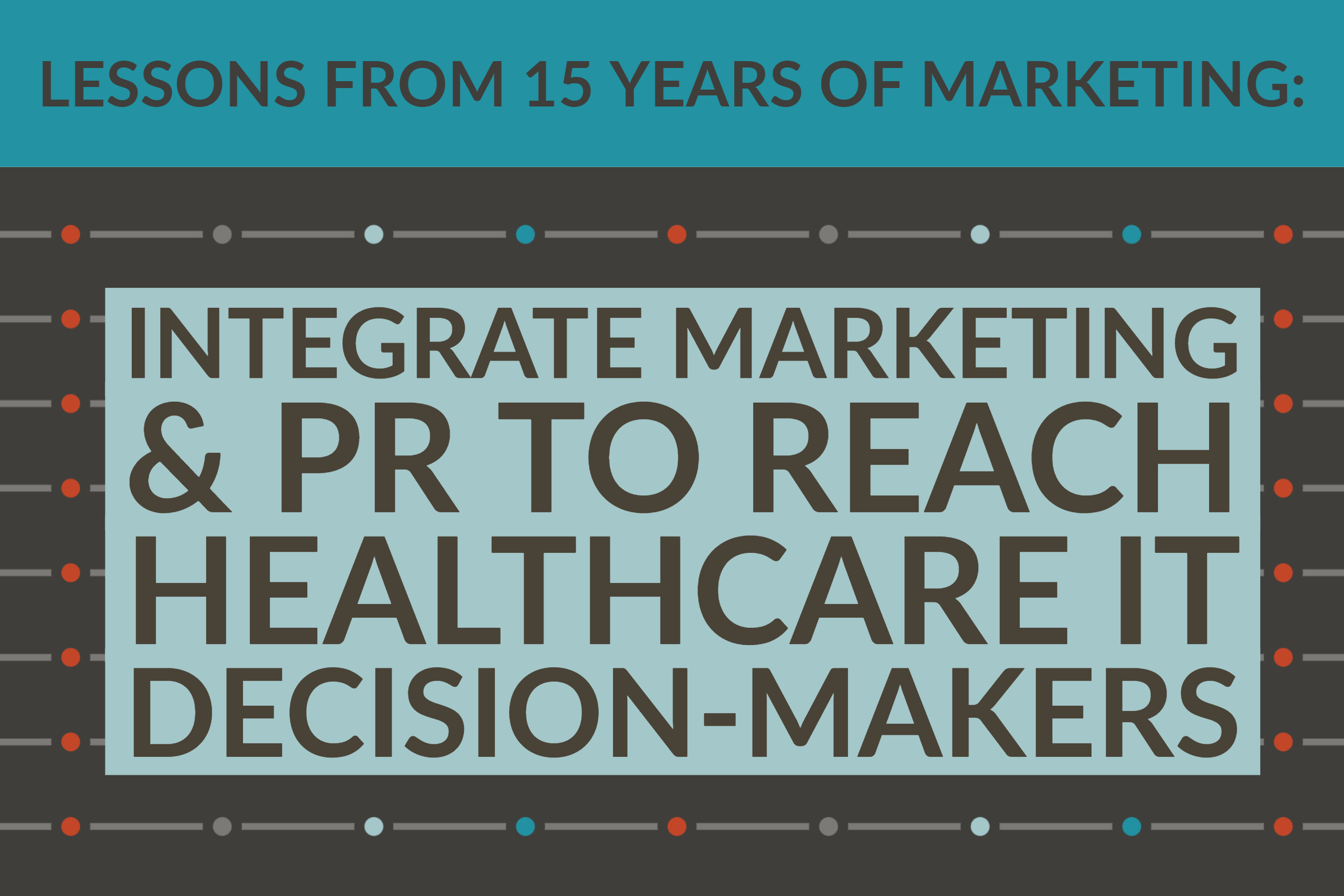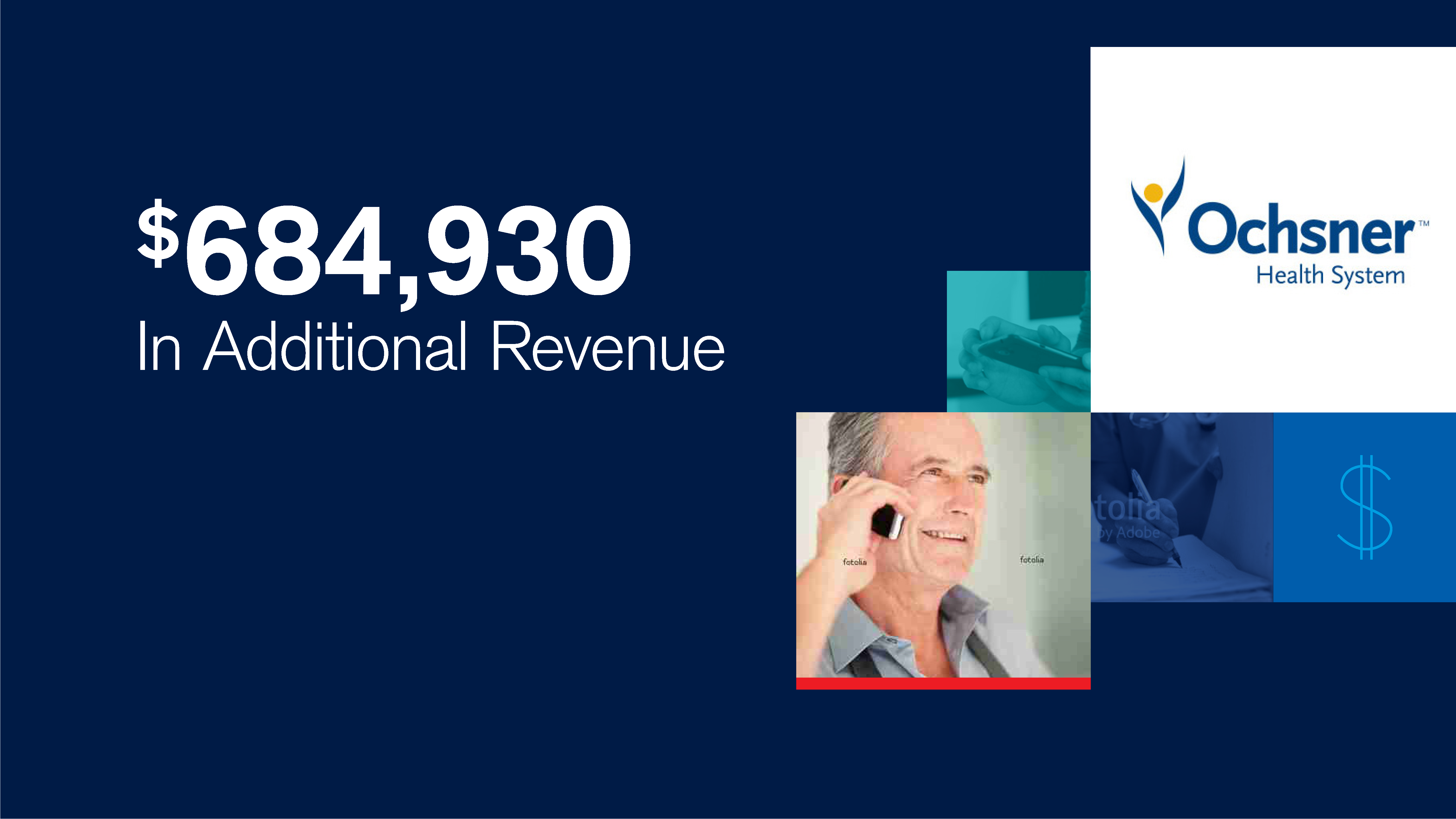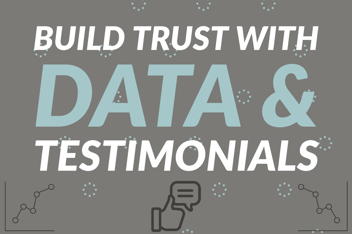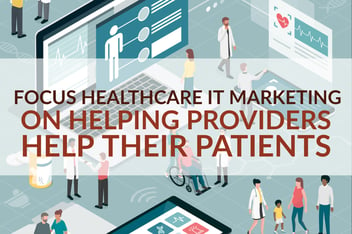Lessons From 15 Years Of Marketing: Integrate Marketing & PR To Reach Healthcare IT Decision-Makers
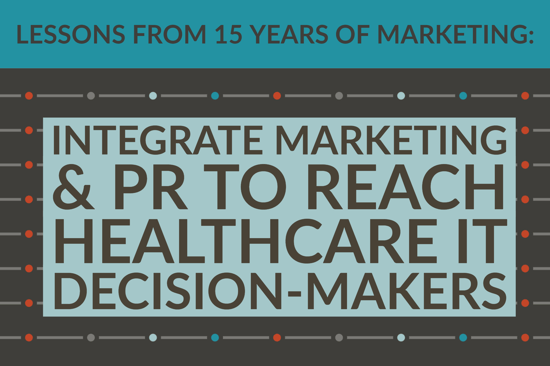
In my last two articles in this series of lessons in marketing, I’ve talked about the importance of trust when dealing with finances and money, and the importance of understanding the science when marketing in the life sciences industry. Healthcare IT is another field in which decisions are made slowly, based on data and authority.
That means building a strong reputation through both PR and marketing, rather than keeping each communication channel siloed in its own track and potentially mixing messages between the two departments. An integrated approach to marketing and PR is more efficient and effective, presenting a cohesive unified message across all channels. Building a strong strategy for marketing healthcare IT solutions requires understanding who the decision makers are and what information they need in order to believe that your company offers the right solution.
-------------------------------------------------------------------------------------------------------
This post is one in a 15-part series looking back at the lessons learned in my 15 years as founder and owner of JONES Marketing & PR. Find the two most recent posts in the series here:
-
Lessons From 15 Years: FinTech Marketing Starts With Authority & Trust
-
Lessons From 15 Years: Expertise Essential For Marketing Within The Life Sciences Field
-------------------------------------------------------------------------------------------------------
My Marketing Lesson #9 (Industry Highlight): Marketing for healthcare IT solutions begins with understanding your customer personas and key industry trends, and then builds a comprehensive integrated PR and marketing strategy based on solid data, executed across all communications channels.
Here is my five-step guide to planning and executing an integrated communications strategy for healthcare IT organizations.
1. Understand that you are marketing primarily to the CIO or IT director when marketing healthcare IT and software solutions.
Before diving full-force into any PR and marketing strategy creation, it is important to understand exactly who you are marketing your solutions to — who is making the purchasing decision, who has influence in that decision, what their pain points are, how they gather information, and what kinds of information they need before making a purchase decision. All of these questions are part of creating complete customer or buyer personas.
While you may have several different personas for any one product or service, there is typically one that stands out above the others in influence. In the case of healthcare IT decisions, that person is typically the chief information officer or director of IT. Other job roles that may influence healthcare IT purchases may include the CEO, CFO, or senior level users of the technology in question, but the final decision is often greatly influenced by the CIO.
It is essential to consider how CIOs typically gather information, where they look for recommendations, and what type of decision-making process they use.
Healthcare IT purchase decisions tend to involve long buying cycles — they don’t want an immediate sales pitch. And those decisions tend to be made once a level of trust has been developed, which is why we design integrated PR and marketing campaigns for this industry focused on a long-term outcome, not immediate sales. Trust is built by providing information and content that helps CIOs in their jobs, rather than focusing everything around the sale. This is why JONES focuses on integrated campaigns that utilize both PR and marketing channels — from contributed articles to blogs, social media and downloadable reports — to share results of research and other insights that help our clients’ customers improve outcomes.
CIOs also tend to look to their colleagues in the field for referrals and recommendations, as Modern Healthcare points out. (Source) Peer experiences and referrals can play a huge role in multi-million-dollar decisions. This makes content such as case studies and customer testimonials an essential element in overall marketing strategies.
2. Focus on key trends and how to solve problems that impact both the organization and patient outcomes.
In a previous post, we outlined six ways to pinpoint customer pain points in order to develop marketing content ideas. It includes listing what problems you solve, what questions your customers frequently ask, what types of content your customers may share, and what your competitors are talking about in their marketing and PR content.
You will likely find that your own list may include similar themes to the issues topping lists of concerns for healthcare CIOs and IT directors, as these key stakeholders address what Healthcare IT News calls “ceaseless digital evolution.”
According a report from LexisNexis Risk Solutions, healthcare organizations that are still building their infrastructure are most interested in cybersecurity and in developing interoperability between departments, functions and locations. For those healthcare organizations with robust systems already in place, the focus shifts to analytics and patient engagement. (Source: Healthcare IT News)
While electronic health records (EHR) may be one of the most obvious fields in which healthcare organizations are turning to IT solutions, many are also seeking ways to automate tasks and increase efficiency throughout the organization, from supply chain management to billing. In doing so, HealthTech Magazine notes that CIOs have a need to be seen as innovators in developing corporate strategies, not just as the people maintaining the back-end infrastructure.
Additional topics identified by HealthITAnalytics as important to its readers right now include population health management, chronic disease management, and health information governance.
Address these trends and needs in your content in order to position your healthcare IT solutions with those making the decisions. Highlight how you can solve problems and improve both the healthcare organization’s success and patient outcomes.
Longtime JONES partner West (now Intrado) has taken this approach in many of its PR and marketing campaigns, recognizing that while healthcare organizations are concerned with their own efficiency and bottom line, they are also focused on care quality and patient outcomes.
As a result of one of West’s surveys exploring how healthcare providers can use automated notification technology to encourage patients to schedule preventive care screenings — increasing patient usage of services and potentially catching conditions at an early stage for better patient outcomes — Oschner Health System in Louisiana engaged West to deliver automated phone notifications to 3,137 patients with recent orders for a colonoscopy or endoscopy screening. As a result, within two months 578 patients had scheduled the procedure, generating an estimated $684,930 in revenue for Oschner and potentially identifying 145 patients with precancerous or cancerous polyps. (More details on West’s use of surveys to fuel marketing and PR content is in section 4 of this article. Keep reading!)
Click this image for a problem-solution video JONES created for West highlighting the Oschner success and other client testimonials.
From your own company’s standpoint, also consider if you can market solutions to drive organic growth – getting your existing customers to increase their spend by using your technology in new ways or by upgrading to more features. West is again a strong example for using this approach, recognizing that increasing usage by current customers can often be more cost-effective than focusing strictly on acquisition of new customers who must make a significant investment to implement a new solution. By finding new ways for healthcare providers to utilize the West notification technology they already have in place – in new ways – West captures additional revenue through a pay-per-use billing structure.
3. Take an integrated approach to PR and marketing content strategy creation and campaign planning.
With a list of industry trends and buyer persona pain points in mind, it is time to create the overarching content strategy and specific campaigns that you will implement in the coming months.
JONES believes that all businesses, including the healthcare IT industry, benefit from integrating PR and marketing efforts to present uniform messaging to prospects and customers at all stages of the sales funnel, from those just learning of your business through awareness level media outreach to those making final purchase decisions.
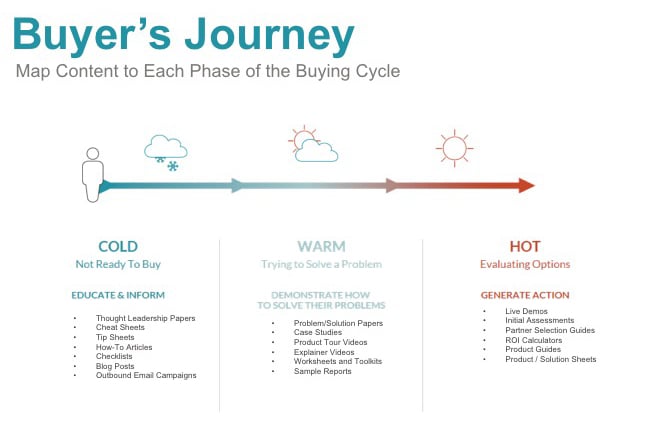
We recommend a strategy that incorporates multiple content types, distributed through multiple channels, centered around common themes to create individual campaigns. The content strategy comes first. And, each integrated PR and marketing campaign should be designed to deliver a series of content pieces to support each phase of the buyer’s journey (or sales funnel), strategically tailored and distributed across every marketing and PR channel.
As part of our work with AccuReg, a healthcare IT provider offering hospitals registration and billing software, we outlined a year’s worth of campaigns based on a strategy that called for each campaign to include content pieces targeting “cold,” “warm,” and “hot” prospects.
Included would be:
-
Blog posts
-
Outbound emails
-
A tip sheet
-
How-to thought leadership articles
-
A problem-solution paper
-
Case studies
-
Sample reports
-
Product/solution sheets
-
A partner selection guide
-
Live demos
-
Customer testimonials
-
Website sliders/calls-to-actions
-
Landing page copy
-
Nurturing emails and workflows
Each content piece would address the specific needs of the identified customer persona (in this case, hospital CFOs) at a specific point in the buyer’s journey.
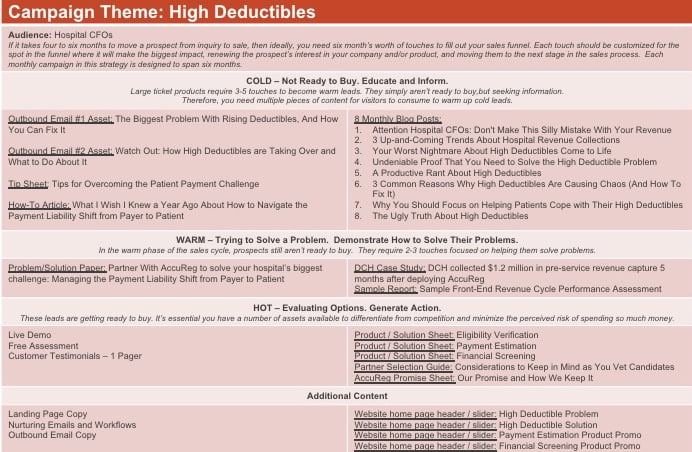
Download a template for a similar campaign plan here: Campaign Calendar Planning Template.
4. Build content off solid data and concrete solutions.
In more than a decade working with West, we learned that the healthcare industry, and IT decision-makers in particular, respond best to marketing and PR content that is extremely well-researched, and offers new and compelling data. We built dozens of campaigns around the results of surveys of healthcare providers and patients, highlighting challenges in the healthcare industry and ways the industry can move to solve those problems.
We guided West through conducting more than 20 surveys, resulting in thousands of individual pieces of content that provide hard data to our audiences.
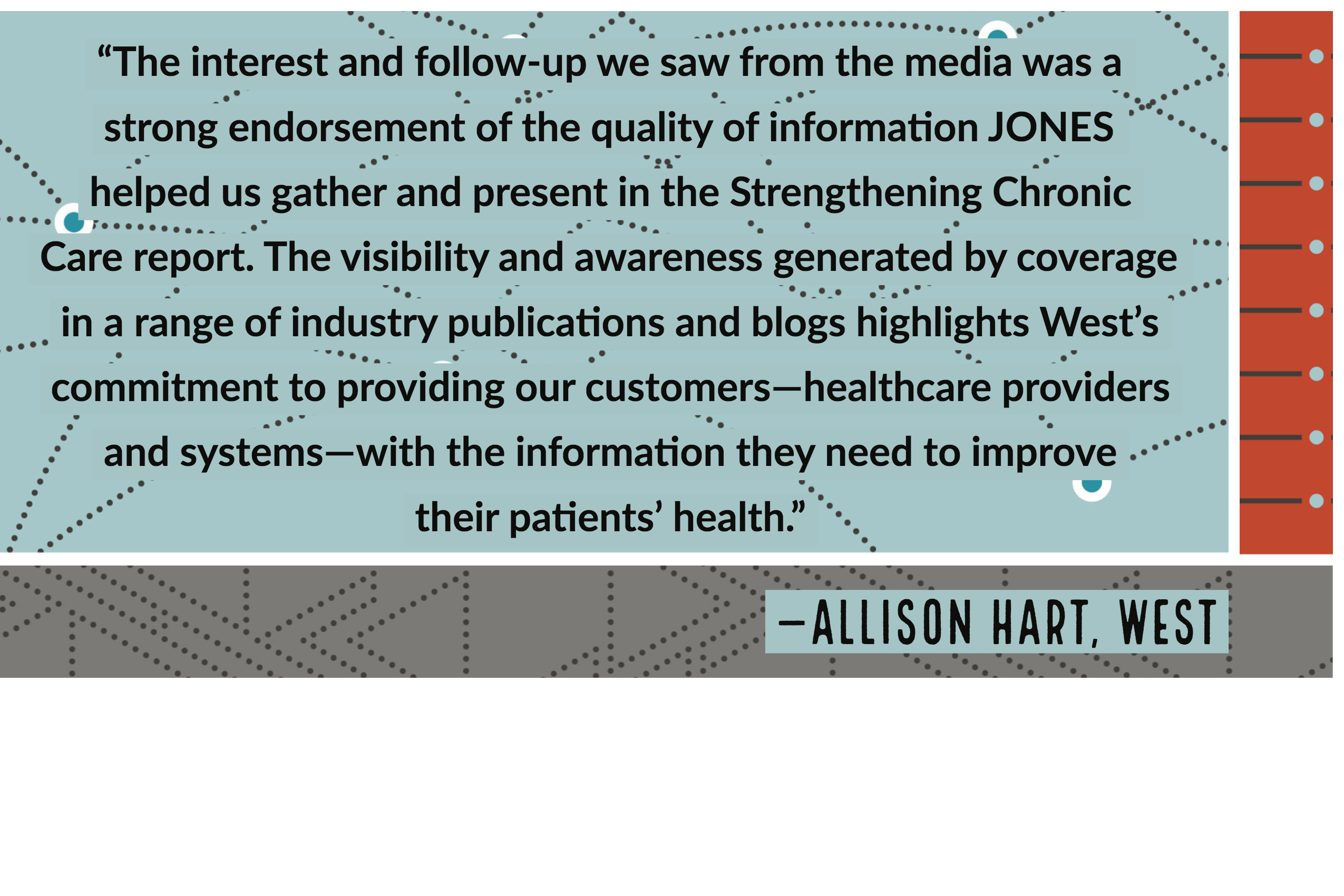
The company’s 2018-2019 campaigns focused on the data from a survey conducted in January of 2018. A few of the thought leadership articles placed during those campaigns include:
-
Managed Healthcare Executive: Baby Boomers and Millennials Want More Frequent Communication
-
Health IT Outcomes: Consistent Communication Helps Providers Deliver Better Healthcare Experiences
-
Becker’s Hospital Review: Online Surveys: A Solution For Helping Patients Better Manage Health
Much of the success of West’s thought leadership outreach, as well as media and bloggers’ response to utilizing the 25 infographics created from that same survey data, is based on a history of JONES and West gathering solid information with relevant applications for the readers of those publications and for West’s customers. (More on placing bylined articles: Q&A: How JONES And West Use Contributed Articles In Marketing Campaigns.)
Of course, the strategy didn’t end with thought leadership. We guided West through a complete integrated approach using that information that also developed 17 marketing papers, more than 50 blog posts and hundreds of social media posts, maximizing the impact of a single survey and focusing on cohesive messaging and campaigns to drive results.
Download these free resources for a guide to using surveys as the basis for PR and marketing content: Consumer Survey Development Guide & Template and Maximizing Marketing Surveys: How To Turn 1 Survey Into 100+ Content Concepts.
5. Deploy content across all marketing channels and levels of the sales funnel to maximize ROI on data collection and content development.
JONES and West have successfully created extended campaigns that disseminate content through a wide range of marketing and PR channels, repurposing the information gathered through surveys and independent research to maximize the return on those efforts.
Content created from survey data includes thought leadership articles, placement of infographics, published reports, blog posts, videos, and sales enablement materials used at conferences, trade shows and in one-on-one sales meetings. (Find full details of how JONES helped West leverage all of these pieces during the Healthcare Information and Management Systems Society (HIMSS) 2017 conference in this blog post: Client Success: West Turns Original Research Into Lead Generation, Media Coverage.)
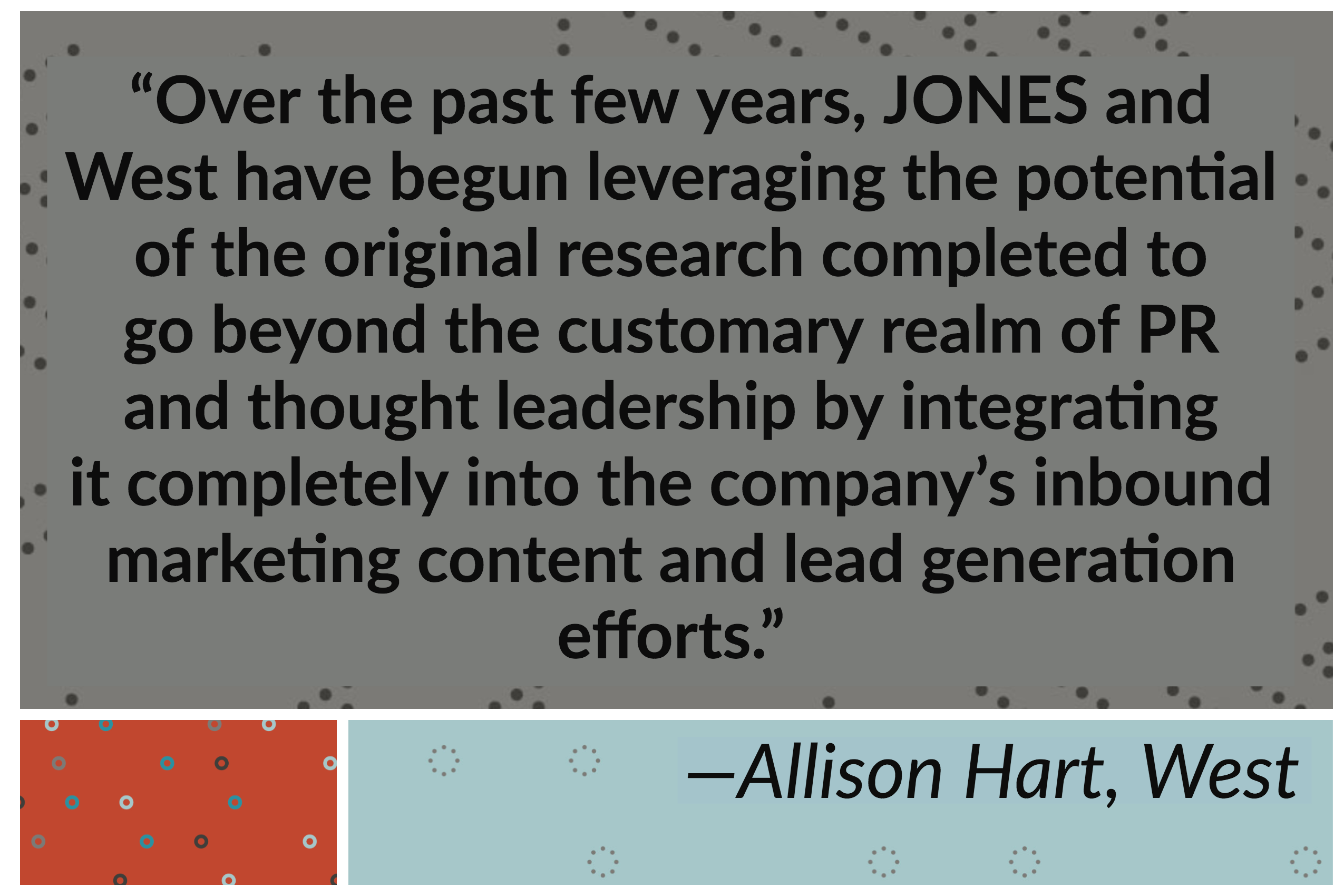
Rather than using the data collected only for public relations, or only for a single marketing channel, West and JONES make the most of the information gathered by using it across channels to reach audiences at all stages of the buyer’s journey.
We believe in repurposing and maximizing information as much as possible in order to provide our clients with the best return on investment for the research and content development time involved.
As you may have gathered from this article, I believe strongly in integrating PR and marketing. In fact, I believe so strongly in it that my next post in this series of 15 lessons from 15 years as a marketing agency owner will focus on why the two should be tightly tied together. I’ll also talk about the importance of “doing the data-work”: measuring results, media analysis, and audits. If you want to be sure you see that article, and the remaining 5 to follow, subscribe now the Inbound Accelerator to have updates delivered to your inbox.
-1.png?width=1652&height=294&name=Jones(RGB)-1.png)

